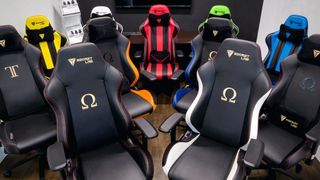Channel your inner Professor X by turning your gaming chair into Cerebro with this strap-on 7.1.2 surround sound speaker
It might just help you to sit better in your chair and avoid the dreaded 'gamer hunch', too.
Ten years ago, my gaming setup didn't look massively different to what I have now, with one noticeable difference—while I always use a headset now, back then I had a massive 5.1 speaker system. Such setups are no longer very popular but one audio company reckons it has just thing to bring them back to the fore: Cerebro. Wait, sorry—the Colo GCS by Cololight.
What Cololight has done is take 11 speakers to create a 7.1.2 audio landscape (seven primary channels, one low-frequency channel, and two 'overhead' channels), but rather than have them dotted around your gaming room, it's placed them in a large U-shaped ring that straps onto your gaming chair's headrest.
To be honest, mere words aren't enough to describe how astonishing the thing looks, and I can't quite decide if that's a good thing or a bad thing. Let's start by considering the aspects of it that make it seem good.
Cololight lists a variety of reasons why its design is better than headsets and soundbars, such as comfort, space requirements, and the fact that such setups only simulate surround sound. They're all valid complaints but the right gaming headset will be comfortable for hours of use and soundbars, even those with sub-woofers, aren't especially massive.
The point about simulating surround sound has become far less relevant these days, as most gamers will be more than happy with what a stereo headset can generate. A true surround sound system does...err…sound epic, though.
It'd be quite unfair to judge something negatively without trying it first, but a couple of things do stand out for me. The first, and most obvious, is that the whole system is pretty close to your head so it makes me wonder how frequently one is likely to bounce one's bonce off it, just from getting up from the chair.
This leads to my second concern: how stable and strong the attachment system is. Basically, the whole thing straps to a chair's headrest, and the Colo GCS has been specifically designed to work on e-sports/gaming chairs, so there's a chance it might not fit your chair particularly well.
The biggest gaming news, reviews and hardware deals
Keep up to date with the most important stories and the best deals, as picked by the PC Gamer team.

Best chair for gaming: the top gaming chairs around
Best gaming desk: the ultimate PC podiums
Best PC controller: sit back, relax, and get your game on
Even if it does, I have questions about how much the system will move about. Are those arms very rigid or will they flex about in gaming?
Lastly, having a wire dangling down the back of one's gaming chair means there's always a risk of running over it, as you move the chair about. With a wireless gaming headset, that's never going to happen and unlikely even with a wired one.
I have no doubt that some gamers will be looking at this and thinking that this is an awesome idea. However, at the moment, Cololight's Cerebro isn't available—as its webpage just refers to an Indiegogo campaign—but in a document sent to us, Cololight's asking $599 for the Colo GCS.
That's cheaper than a full surround system but a heck of a lot more than a decent gaming headset. I suppose that even if it doesn't live up to all the claims, you can't deny that it'll give your gaming den a full-on Professor X vibe.

Nick, gaming, and computers all first met in 1981, with the love affair starting on a Sinclair ZX81 in kit form and a book on ZX Basic. He ended up becoming a physics and IT teacher, but by the late 1990s decided it was time to cut his teeth writing for a long defunct UK tech site. He went on to do the same at Madonion, helping to write the help files for 3DMark and PCMark. After a short stint working at Beyond3D.com, Nick joined Futuremark (MadOnion rebranded) full-time, as editor-in-chief for its gaming and hardware section, YouGamers. After the site shutdown, he became an engineering and computing lecturer for many years, but missed the writing bug. Cue four years at TechSpot.com and over 100 long articles on anything and everything. He freely admits to being far too obsessed with GPUs and open world grindy RPGs, but who isn't these days?
Most Popular







